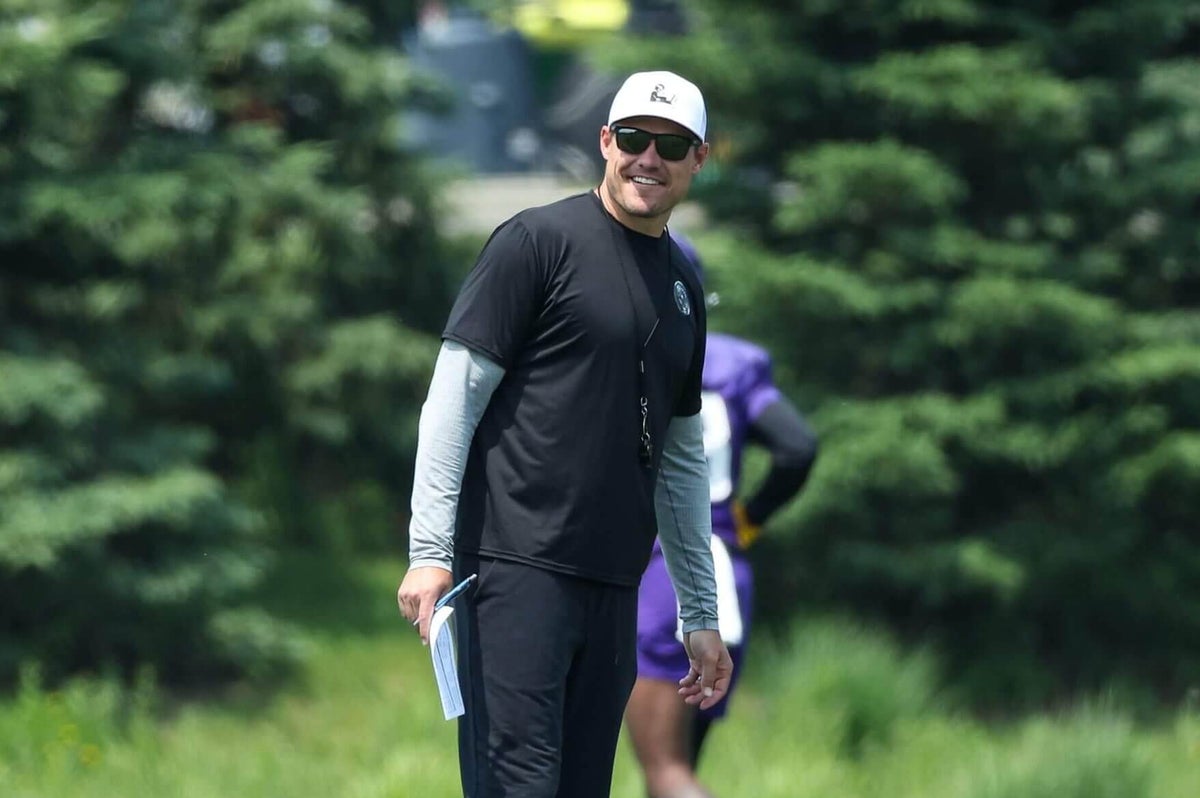EAGAN, Minn. — If you saw Kevin O’Connell’s desk, you would probably spot a calendar. Squares with scribbled notes about workouts. Sheets offering tidbits on scheduling.
You’d see the same intentionality that’s on display when the Minnesota Vikings play on Sundays. Three years as an NFL head coach has given O’Connell an array of information on when to teach what and how hard to push for how long.
This is no exact science. Weather changes. Some rosters are younger, others older. Some quarterbacks or centers or defensive signal callers need more time on various layers of the system. O’Connell does not view the challenge lightly or roll his eyes at any of the components.
“We’ve got to come out (in the regular season) with some real momentum,” he said during Tuesday’s news conference, a nod to the midseason gauntlet against the Eagles, Chargers, Lions and Ravens. “How do you do that? You have a good training camp.”
We understand what we’re capable of but we’ve got to put in a lot of work to feel totally worthy in those moments to get to where we want to get to. pic.twitter.com/1LiFgJ1Niv
— Minnesota Vikings (@Vikings) July 22, 2025
Good, for this iteration of the Vikings, will involve a significant dose of speed and physicality. This must be more than a dynamic passing offense. A defense without the ability to rush four men won’t cut it. Molding the body for swiftness won’t matter if the Vikings cannot create a hardened edge.
Three years ago, the Vikings practiced with more of a new-age feel, a workload intended to maintain overall health. And it worked. Minnesota would not have won 13 games in 2022 if it weren’t for player availability.
Last year, the Vikings tweaked their approach to incorporate more contact. They believed it was their most productive preparation period under O’Connell. In the coach’s opinion, the structuring contributed to the defense’s readiness at the outset as well as the ability to prioritize an improved run game.
If anything, with a team fixated on being up for the challenge deep into the winter, the Vikings plan to match last year’s toughening strategy — and then some. Expect back-to-back days of players in pads. Expect 11-on-11 opportunities during which players like Justin Jefferson are gliding in and out of cuts with maximum output.
“Same type of feel,” O’Connell said of his plans for the rest of the summer.
The Vikings will methodically drift from zero to 100, starting with the classroom sessions to establish the basics. The first conversation in most of the third-floor rooms? Turnovers are the highest priority: creating them on defense and preventing them on offense.
Minnesota would not have won 14 games last season if it weren’t for turnovers. Training camp practices would often begin with players diving onto cushions to secure loose footballs. Cornerbacks caught passes from coaches to imitate interceptions. You’d have to think these daily drills had something to do with the team’s 33 forced turnovers, which tied for first in the league.
In 2024, the team that won the turnover margin won 77.7 percent of the games. O’Connell’s record (17-2) when winning the turnover margin is even better. Hence, the team’s continued focus.
From there, the Vikings will move to the daily on-field installs, supplying young quarterback J.J. McCarthy with chances to rehearse so much of what he’s learned over the last year. Eventually, O’Connell will structure throwing periods to mimic game situations.
He’ll walkie-talkie plays into McCarthy’s helmet. He’ll watch McCarthy operate in the huddle, at the line of scrimmage when he’s hollering the cadence and in the pocket when he’s going through his progressions. After throws, during the backups’ reps, they’ll review McCarthy’s decision-making and how it ties to specific scenarios.
You may recall this being one of the tentpole progression points of Sam Darnold’s 2024 season. Following the midseason nosedive of interceptions against the Colts, Titans and Jaguars, the Vikings staff reiterated to Darnold the need to stay within himself on third downs.
“People want to talk about the game-manager position,” O’Connell said. “All 32 (starters) better manage the game, or you’re going to lose. I think we can simulate that.”
How well McCarthy takes to all of his tasks will affect everything else. Does center Ryan Kelly need to absorb more pre-snap responsibilities to make things easier? Is McCarthy sufficiently prepared and thriving so they can push deeper into the playbook? It is incumbent on the entire staff to sense the path before they travel down it and have to turn back.
These tiny decisions tend to go unnoticed, but perhaps they’re at the core of why the Vikings have been so successful. The challenge now, of course — for this season and beyond — is to push that success into the next calendar. To win not just once in the playoffs but multiple games.
That’s why this leadership group moved on from Kirk Cousins. That’s why it stuck with the McCarthy plan. That’s why it overhauled the interior of the offensive line. That’s why it reinforced the defensive line.
The idea is that this path, surrounding a young quarterback contract with expensive players across the roster, is the one with the highest odds of achieving the elusive prize. The idea is that this team, fortified up front and deeper at the edges, is more equipped than it has been to win the way that’s required.
“The idea is that this is the type of team that can show up to a fight — not knowing what the fight is going to be — and be the last one standing,” general manager Kwesi Adofo-Mensah said Tuesday. “We wanted to build the type of team that was versatile, that could win in different ways. And we think we’ve done that.”
The thinking is done. The calendar is complete. The fun awaits.
(Photo: Matt Krohn / Imagn Images)
